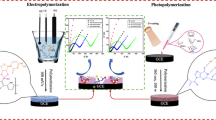Abstract
The selectivity of carbohydrate-imprinted polymers for several disaccharides, namely cellobiose, maltose, lactose and gentiobiose, is investigated. An ternary ligand–Cu(II)–carbohydrate complex was formed in alkaline solution and captured afterwards in the polymer. The accessibility of the polymer matrix for disaccharides was investigated by HPLC analysis, refractometry and 1H NMR spectroscopy applying excess of the original template during rebinding experiments under saturation conditions in unbuffered, aqueous solution at neutral pH and 20 °C. The selective discrimination of the α- and β-glycosidic linkage of cellobiose and maltose is demonstrated. It is further shown, that the disaccharide-imprinted polymers slightly distinguish between the 1,4-β- and the 1,6-β-glycosidic linkage of cellobiose and gentiobiose, while cellobiose and lactose are not selectively recognized. Due to the weak apparent binding constant of the functional Cu(II) monomers with the targeted disaccharides at physiological pH, the recognition process is dominated by the shape of the created imprinted cavity under the applied conditions.
Similar content being viewed by others
References
Allmann R, Krestl M, Bolos C, Manoussakis G & Nikolov GS (1990) The crystal and molecular structures of (diethylenetriamino) copper(II) nitrate. Inorg. Chim. Acta 175: 255-260
Backman I, Erbing B, Jansson PE & Kenne L (1988) NMR and conformational studies of some 1,4-linked disaccharides. J. Chem. Soc. Perkin Trans. 1: 889-898
Chen GH, Guan ZB, Chen CT, Fu LT, Sundaresan V & Arnold FH (1997) A glucose-sensing polymer. Nat. Biotechnol. 15: 354-357
Connors KA (1987) Binding Constants-The Measurement of Molecular Complex Stability, John Wiley & Sons, New York.
Davis AP & Wareham RS (1999) Carbohydrate recognition through noncovalent interactions: a challenge for biomimetic and supramolecular chemistry. Angew. Chem. Int. Ed. Eng. 38: 2978-2996
Dickert FL & Hayden O (2000) Molecular fingerprints using imprinting techniques. Adv. Mater. 12: 311-314 314
Haupt K & Mosbach K (2000) Molecularly imprinted polymers and their use in biomimetic sensors. Chem. Rev. 100: 2495-2504
Ishii T, Iguchi R & Shinkai S (1999) D/L selective rebinding of saccharide-imprinted [60]fullerene-bisadducts based on a saccharide-boronic acid interaction: Development of a molecular imprinting technique useful in a homogeneous system. Tetrahedron 55: 3883-3892
James TD, Samankumara Sandanayake KRA & Shinkai S (1996) Saccharide sensing with molecular receptors based on boronic acid. Angew. Chem. Int. Ed. Engl. 35: 1910-1922
Malitesta C, Losito I & Zambonin PG (1999) Molecularly imprinted electrosynthesized polymers: New materials for biomimetic sensors. Anal. Chem. 71: 1366-1370
Mayes AG, Andersson LI & Mosbach K (1994) Sugar binding polymers showing high anomeric and epimeric discrimination obtained by noncovalent molecular imprinting. Anal. Biochem. 222: 483-488
Nagai Y, Kobayashi K, Toi H & Aoyama Y (1993) Stabilization of sugar-boronic esters of indolylboronic acid in water via sugar indole interaction-a notable selectivity in oligosaccharides. Bull. Chem. Soc. Jpn. 66: 2965-2971
Nicholls IA (1995) Thermodynamic considerations for the design of and ligand recognition by molecularly imprinted polymers. Chem. Lett. 1035-1036
Nilsson KGI, Sakaguchi K, Gemeiner P & Mosbach K (1995) Molecular imprinting of acetylated carbohydrate derivatives into methacrylic polymers. J. Chromatogr. A 707: 199-203
Sander MR & Osborn CL (1973) Acetophenone-type photosensitizers for radiation-curable coatings, US Patent 3715293, licenced to Union Carbide Corp., USA. CA 78: 125919
Sears P & Wong CH (1999) Carbohydrate mimetics: A new strategy for tackling the problem of carbohydrate-mediated biological recognition. Angew. Chem. Int. Ed. Eng. 38: 2301-2324
Steinke J, Sherrington DC & Dunkin IR (1995) Imprinting of synthetic polymers using molecular templates. Adv. Polym. Sci. 123: 85-125
Striegler S (2001) Selective discrimination of closely related monosaccharides at physiological pH by a polymeric receptor. Tetrahedron 57: 2349-2354
Striegler S & Tewes E (2002) Investigation of sugar binding sites in ternary ligand-copper(II)-carbohydrate complexes. Eur. J. Inorg. Chem. 2: 487-495
Wulff G (1995) Molecular imprinting in cross-linked materials with the aid of molecular templates-a way towards artificial antibodies. Angew. Chem. Int. Ed. Engl. 34: 1812-1832
Wulff G (1997) Imprinting techniques in synthetic polymers-new options for chemosensors. In: Scheller FW, Schubert F & Fedrowitz J (ed.) Frontiers in Biosensorics I-Fundamental Aspects (pp. 13-26) Birkhäuser Verlag, Basel.
Wulff G & Schauhoff S (1991) Enzyme-analog-built Polymers. 27. Racemic-resolution of free sugars with macroporous polymers prepared by molecular imprinting-selectivity dependence on the arrangement of functional-groups versus spatial requirements. J. Org. Chem. 56: 395-400
Author information
Authors and Affiliations
Rights and permissions
About this article
Cite this article
Striegler, S. Investigation of disaccharide recognition by molecularly imprinted polymers. Bioseparation 10, 307–314 (2001). https://doi.org/10.1023/A:1021589619501
Issue Date:
DOI: https://doi.org/10.1023/A:1021589619501




